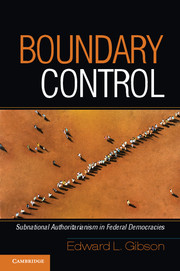5 - Boundary Control in Democratizing Mexico
Published online by Cambridge University Press: 05 January 2013
Summary
Democracy from the provinces: and why not?
Vicente Fox Quesada, PAN Governor of the State of Guanajuato, in 1995Only God can remove a governor.
Ulíses Ruíz Ortíz, PRI Governor of the state of Oaxaca, in 2006In 2010, a subnational bastion of autocratic rule in Mexico came to an end. In the southern state of Oaxaca, the Partido Revolucionario Institucional (PRI) lost a governorship it had held for more than 70 years. The PRI succumbed to a coalition of parties united not by ideology but by the goal of defeating the incumbent party. The local leaders of the right-leaning Partido Acción Nacional (PAN) joined local leaders of the left-leaning Partido de la Revolución Democrática (PRD) to support an ex-PRI politician in his long-standing quest to become governor of the state. Added to this complicated local picture were the actions of national parties, which, with national objectives in mind, encouraged and empowered the anti-incumbent coalition.
The defeat of the PRI in Oaxaca was a party-led transition from subnational authoritarian rule. Its protagonists were local party activists, civil society organizations, and national party leaders. Bureaucrats from Mexico City kept their distance, and when they did intervene over the years it was usually on behalf of local incumbents. It was a long and hard-fought struggle. The leviathan was weakened gradually by pitched electoral battles in municipal and state arenas, violent confrontations on city streets and rural byways, and national partisan and regulatory pressures.
- Type
- Chapter
- Information
- Boundary ControlSubnational Authoritarianism in Federal Democracies, pp. 112 - 147Publisher: Cambridge University PressPrint publication year: 2013
References
- 1
- Cited by

